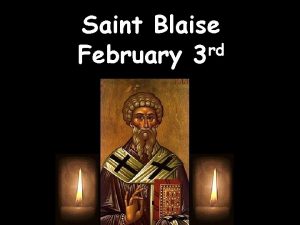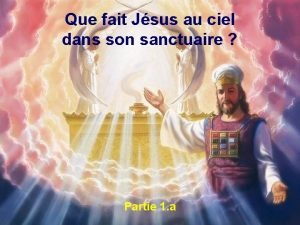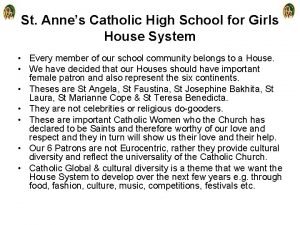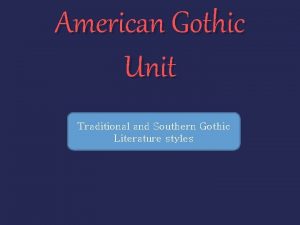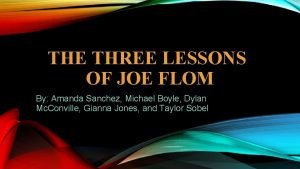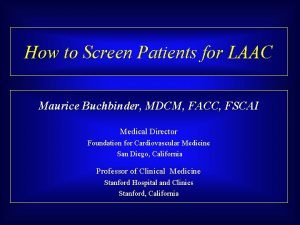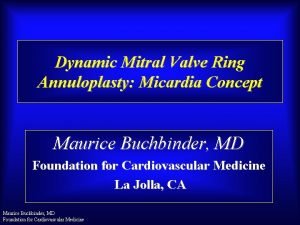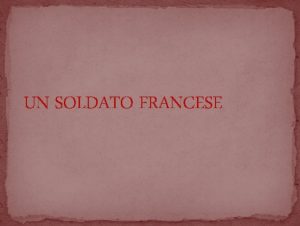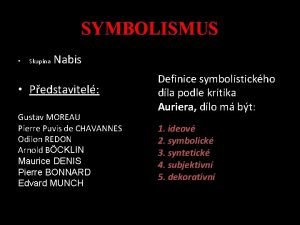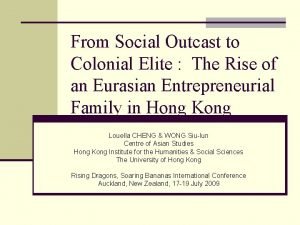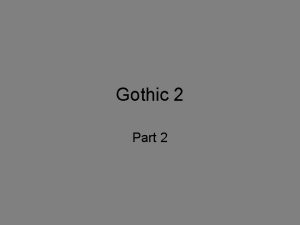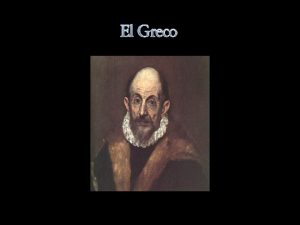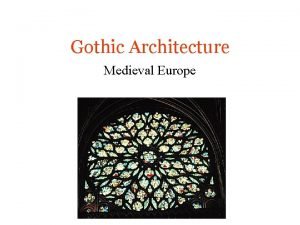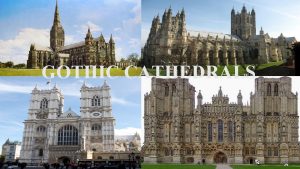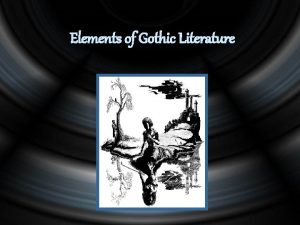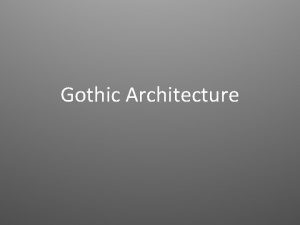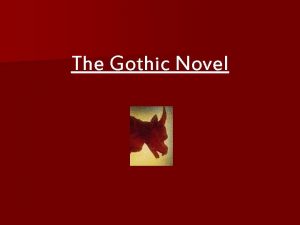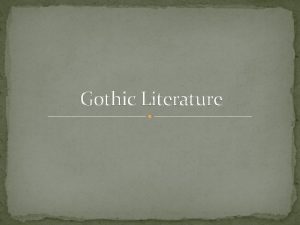Gothic 2 Part 2 Title Saint Maurice Medium















- Slides: 15

Gothic 2 Part 2

Title: Saint Maurice Medium: Dark sandstone with traces of polychromy Date: c. 1240– 50 Source/ Museum: Magdeburg Cathedral, Magdeburg, Germany+ He was the patron saint of several professions, locales, and kingdoms. He was also a highly revered saint in the Coptic Orthodox Church as Maurice was a Black Christian from Thebes, Egypt. considered to be the first realistic depiction of an ethnic African in Europe. Unfortunately, the figure is no longer complete and misses the lower legs and an item in the right hand, presumably a lance. Warrior saint in chain mail Based on living model instead of idealized forms

Title: Ekkehard and Uta Medium: Stone, originally polychromed Size: approx. 6'2" (1. 88 m) Date: c. 1245– 60 Source/ Museum: West chapel, Naumburg Cathedral, Naumburg, Germany Ekkehard and Uta are among a group of life size sculptures of 12 ancestors of a bishop who was a member of the ruling family of Naumburg. The ancestors were patrons of the church; their images were placed in a new chapel at the west end of the church. Unlike the more idealized French Gothic sculptures, Ekkehard and Uta are treated in a highly individualistic manner, in a style akin to Greek Hellenistic. They reveal a strong naturalistic trend in German Gothic Sculpture

andachtsbild - sculpture serving for private devotion -andachtsbild were devotional images that were intended to inspire contemplation of Jesus’ last hours. The subject matter of the Pietà – is of Mary supporting the dead body of Christ originated in Germany during the 1300’s The artworks called the "Vesperbild" had a representation of the seated Madonna holding Christ’s body across her lap. Sometimes, the works were paintings, but usually the pietas were small sculptures that had been carved out of wood or made out of terra cotta. In comparison to Ancient Greek and Southern European sculptures, the Northern works looked primitive and awkward without realistic considerations for human forms or weight distributions.

Rottegen Pieta. Late Medieval Europe. 1300 -1325 CE. Painted wood. Pieta=pity or compassion in Italian 14 th Century had war, famine, plague, social strife, and people were aware of their early suffering Artists expressed and emphasized the trait of human suffering with powerful, expressive and exaggerated images Christ is distorted and stiff in death and covered with blood Mary cradles him and has a disproportioned sized head with a twisted expression of unbearable grief Viewer is confronted with an appalling icon of agony, death, and sorrow that humanizes 2 sacred people

Title: Church of Saint Francis, Assisi, Italy restored one of the world's focal points of both high art and intense spirituality. Still a major place of pilgrimage, the Basilica of St. Francis is a powerful place for believers and art-lovers alike. The impressive frescoes that decorate the interior were painted by Cimabue, Giotto and others In 1818, the tomb of St. Francis was rediscovered beneath the high altar, after lying hidden for almost 600 years. When the coffin was opened, Francis' skeleton was found fully intact. This is very rare for such a popular medieval saint - had his relics not been hidden, bits of them almost certainly would have found their way into shrines across Europe

Artist: Nicola Pisano Title: Pulpit, Baptistry, Pisa Medium: Marble Size: height approx. 15' (4. 6 m) Date: 1260 His work, which combined Classical and Byzantine-Islamic traditions with Romanesque and Gothic 6 sided structure open on one side for a pupit Corinthian columns flanked by gothic trefoil arches- clover like arches Larges central column with animals and a people on base, lions on outer column guard its base May have been inspires by what often found in churches?

Artist: Coppo di Marcovaldo Title: Crucifix Medium: Tempera and gold on wood Size: 9'7⅜" X 8'1¼" (2. 93 X 2. 47 m) Date: c. 1250– 70 Source/ Museum: Pinacoteca, San Gimignano, Italy In the upper part is an Ascension with a Blessing Christ on top of it. At the left end of the arm are Mary and St. John at the right, the Women of Jerusalem. The background panel features the Kiss of Judas, the Flagellation, and the Preparation of the Cross on the left; and Christ before the Sanhedrin, the Mocking of Christ, and the Deposition on the right. Painted on back too? Why?

The Proto Renaissance 14 th Century Italy In 1204, Latin armies sacked Constantinople and took many valuable devotional objects to Italy and France These object which included icons, influenced Italian art of the period and had a far reaching impact Developments of this time were the precursor to the Renaissance, including an emphasis on volume and spatial representation, and emphasis on value used to create form and an on narrative art French Gothic style was also influential to the art of Italy during this time which included French Gothic architectural motifs such as the pointed arch, increased naturalism in figures, and an emphasis on fluid forms

Artist: Cimabue Title: virgin and child enthroned Medium: wood panel Date: 1280 Byzantine porportions Sightly titled heads Mary sits on a throne of “gilded bronze” High lighting drapery with thin lines of gold His spatial ideas, quest for warming naturalism, and subtle asymmetries influenced later painters

Artist: Giotto Title: virgin and child enthroned Medium: Tempera on wood Date: 1310 Spatial consistency Retained a sculptural form Largely symmetrical Mountain like Mary seems to burst from her throne 3 -d figures through subtle changes in light and form Baby gestures in a blessing Angles create a grand entrance to her throne

Giotto trained under Cimabue in Florence and is considered by many to be the father of modern European painting He may have been the architect of the Scorvegni Chapel because of the surface that made it possible to executehis fresco cycle Giotto created a new kind of pictorial space incorporating realistic depth and using value to create realistic volume in the figures At the time of this commission, Giotto was considered the greatest painter in Florence Enrico Scrovegni, the patron, had the chapel constructed both as a way to make up for his father’s sin of usury which had been written about by Dante in his book Inferno, as well as a means of showing off his family’s wealth in order to gain status and acceptance. The concept of usury is worked into the cycle of the chapel frescoes. The chapel has the life of Mary and Jesus and the Passion of Christ



Artist: Giotto Title: the lamentation Medium: Fresco Date: 1305 Arena Chapel described as the creator of modern painting After his death Jesus is mourned over by a small group of followers, among whom his mother. After that, they lay him in his grave. What is new that you have not seen yet? Any symbols?
 February 3 saint
February 3 saint Lieu très saint
Lieu très saint Saint laura of saint catherine of siena
Saint laura of saint catherine of siena Medium medium 35m newton
Medium medium 35m newton Hot media cold media
Hot media cold media American gothic writers
American gothic writers Title title
Title title Prefatory and supplementary part of proposal
Prefatory and supplementary part of proposal What are the three lessons of joe flom
What are the three lessons of joe flom Maurice buchbinder
Maurice buchbinder Maurice buchbinder md
Maurice buchbinder md Maurice picard
Maurice picard Maurice denis muzy
Maurice denis muzy Auto service zivkovic
Auto service zivkovic Charles henry maurice bosman
Charles henry maurice bosman Maurice wiles miracles
Maurice wiles miracles
